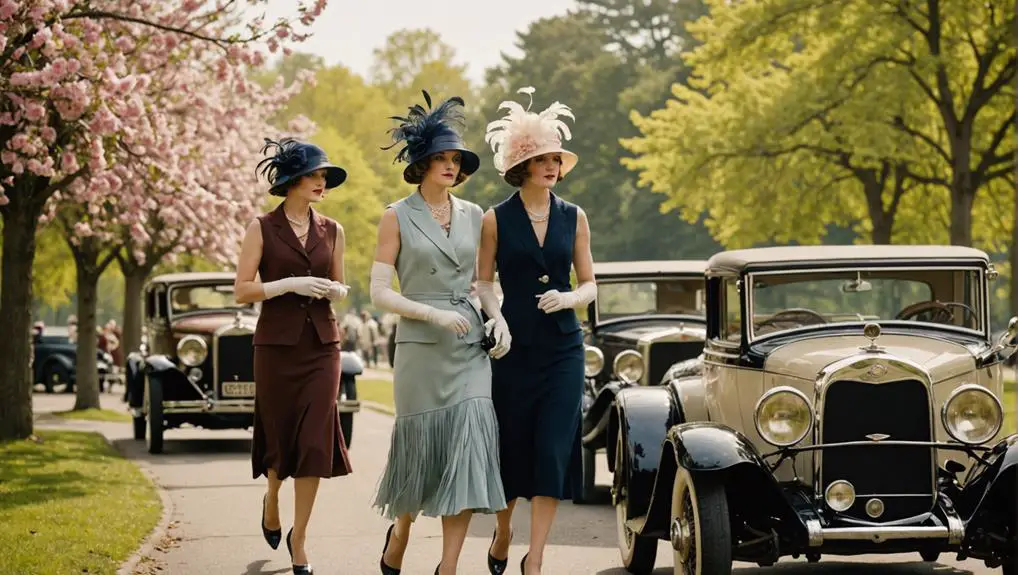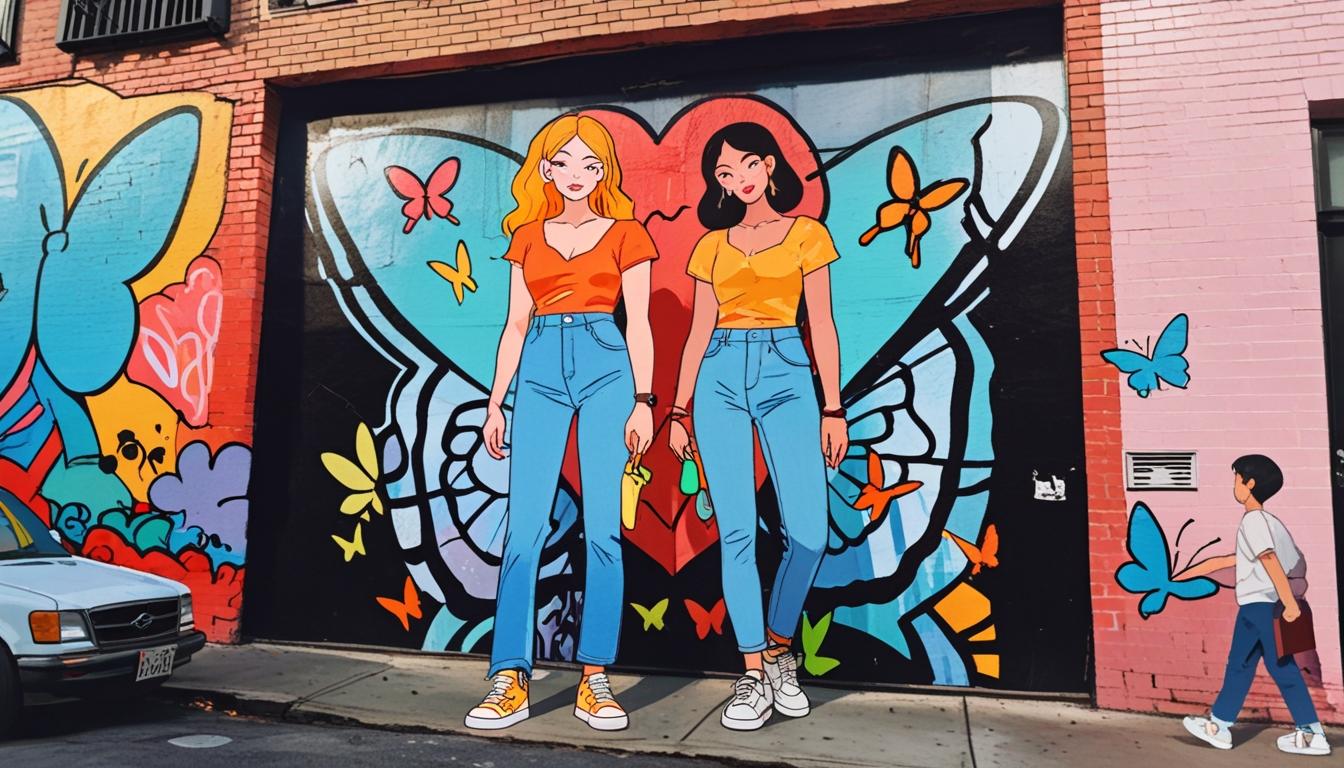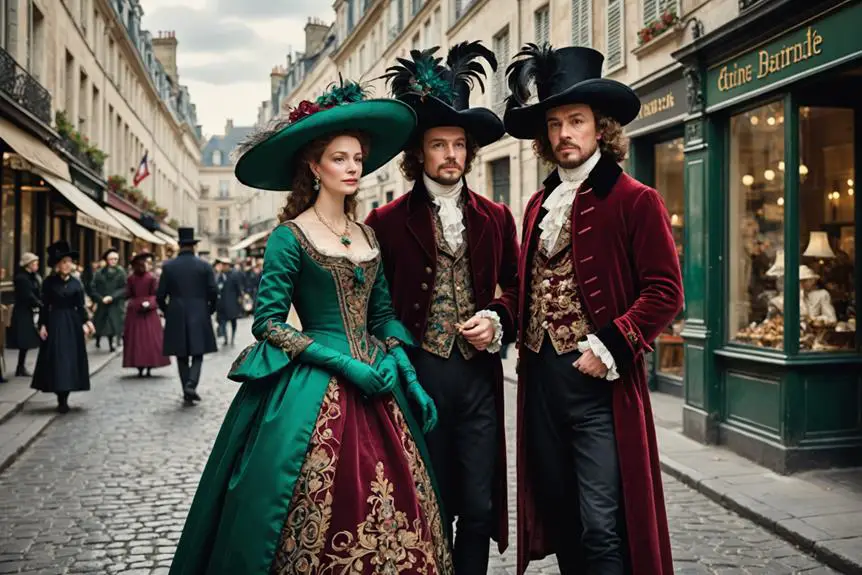In the 1920s, women's cloche hats became iconic symbols of independence and the flapper movement. These fitted, rounded hats, often made from wool or straw, were worn low on the forehead, framing the face with an air of mystery. Cloche hats featured bold designs influenced by the Art Deco movement, showcasing ornate detailing and vibrant embellishments. They were not only stylish but also practical, providing sun protection and comfort. As you explore their historical significance and the designs that defined this era, you'll uncover why these hats continue to hold a special place in fashion history.
Historical Significance
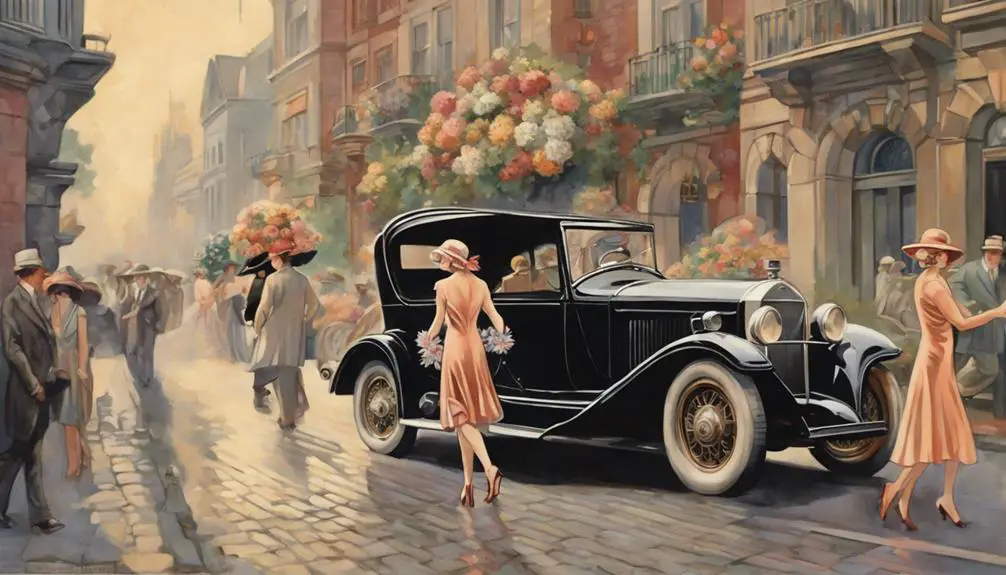
The historical significance of the cloche hat lies in its embodiment of the transformative spirit of the 1920s, a decade marked by dramatic social change and cultural upheaval. As you explore this era, you'll notice how the cloche became an essential symbol of the flapper movement, representing women's liberation and newfound independence. Crafted from materials like wool, the cloche hat's fitted, rounded crown and bell-shaped silhouette offered a striking contrast to previous styles, making a bold statement about modern femininity.
Worn low on the forehead, often obscuring the eyes, the cloche hat exuded an air of mystery and confidence. Its design reflected the Art Deco aesthetics that dominated the period, showcasing the intersection of fashion and contemporary trends in architecture. This fusion not only highlighted the creative spirit of the time but also encouraged women to break free from traditional constraints.
The cloche's rise in popularity in the 1920s established a lasting legacy, influencing fashion trends in subsequent decades. Today, it serves as a reminder of a pivotal moment in history where style and social progress intertwined, making the cloche hat a timeless emblem of change and empowerment.
Types of Cloche Hats
Cloche hats come in a fascinating array of styles, each designed to cater to different preferences and occasions. You'll find options that suit your mood, the weather, or even a specific event. Here are some notable types you might consider:
- Wool Felt Cloche: Classic design with a dome crown and small brim, perfect for cooler weather.
- Summer Cloche: Made from lightweight, packable materials, ideal for warmer months.
- Specialty Cloche Designs: Featuring unique elements like chain link bands or embroidered ribbons for a standout look.
- Trendy Brands: Adora® and Scala Hats offer fashionable varieties that blend classic and contemporary styles.
- Decorative Elements: Look for floral accents, bows, and adjustable inner drawstrings that enhance both aesthetics and fit.
The Wool Felt Cloche typically features a 2-3 inch brim and is available in various colors, making it a versatile choice for formal and casual settings. In contrast, the Summer Cloche boasts a wider brim, often adorned with decorative bows, striking the perfect balance between style and comfort. Whichever type you choose, cloche hats are sure to add flair to any outfit.
Design Features
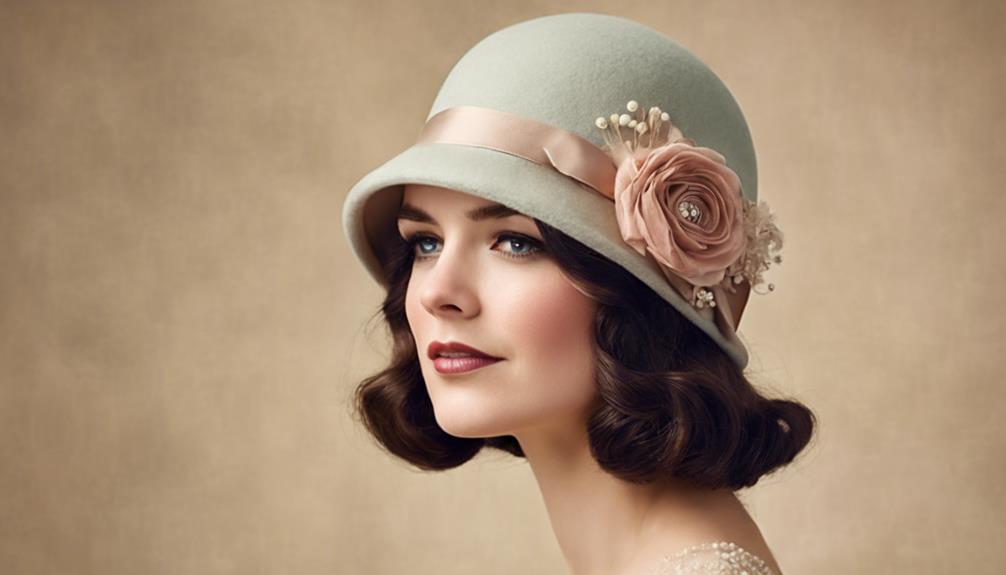
Numerous design features define the allure of women's cloche hats from the 1920s, making them a staple in fashionable wardrobes of the era. The classic cloche hat showcases a rounded crown that snugly hugs the head, allowing you to wear it low on the forehead, with the brim typically resting just above your eyes. This design not only exudes sophistication but also serves a practical purpose in providing shade and framing the face.
Cloche hats were crafted from various materials, primarily felt for the colder months and straw for summer wear. This versatility guaranteed elegance while adapting to changing weather conditions. You'll notice that decorative elements like ribbons, lace, and floral embellishments were often added, enhancing the vintage charm and allowing for individual style expressions.
The brim widths varied from 2 to 3.5 inches, providing options for customization based on your preference and the prevailing fashion trends. Many designs incorporated influences from the Art Deco movement, featuring geometric patterns and ornate detailing that mirror the artistic spirit of the time, making each cloche hat not just an accessory but a statement of style and sophistication.
Practical Uses
Fashion isn't just about aesthetics; it also serves practical purposes, and women's cloche hats from the 1920s exemplify this beautifully. These hats weren't just a trend; they addressed several practical needs for women embracing the dynamic lifestyle of the Roaring Twenties.
- Provided sun protection for outdoor activities
- Offered a secure, stylish fit for active lifestyles
- Served as a chic alternative for women experiencing hair loss
- Versatile enough for both casual and formal occasions
- Lightweight and breathable, perfect for warm weather
Cloche hats acted as effective sun hats, shielding your face from harmful rays while allowing you to maintain a fashionable appearance. Their snug fit guaranteed you felt secure, making them perfect for participating in the activities that characterized the era. Additionally, for women undergoing chemotherapy, these hats offered a stylish solution to hair loss, blending practicality with elegance. The versatility of cloche hats means they seamlessly shifted from day to night, making them indispensable in your wardrobe. With their lightweight materials and breathable designs, cloche hats provided comfort and style, proving that fashion can indeed serve practical purposes.
Pricing and Availability
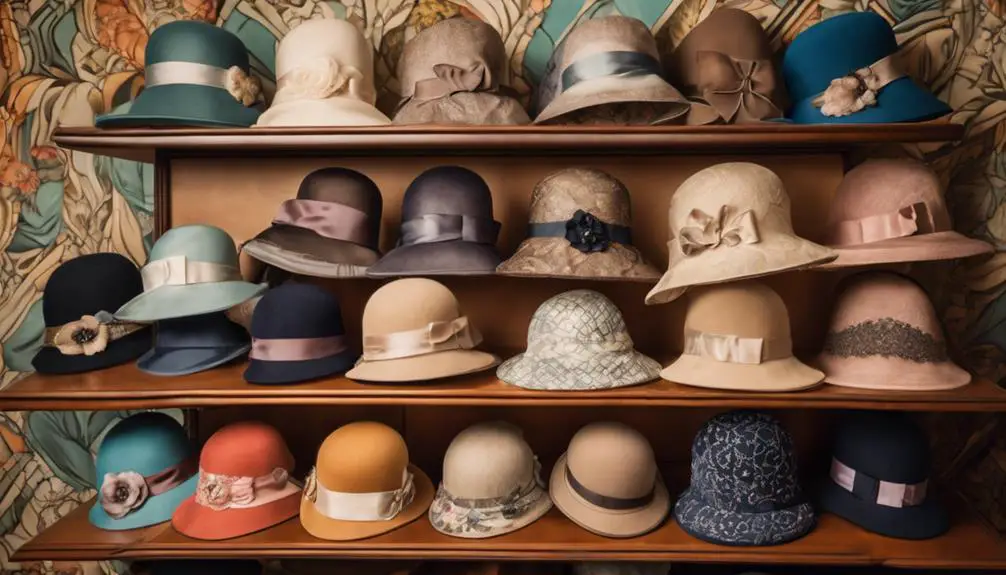
The pricing and availability of women's cloche hats in the 1920s reflected both the burgeoning fashion market and the diverse tastes of consumers. Prices for cloche hats ranged considerably, typically falling between $5.00 and $25.00. This variation depended on factors like materials, craftsmanship, and embellishments. Vintage styles often commanded higher prices, as their unique designs and intricate details made them sought after by fashion-forward women.
For those looking for something truly special, limited edition and handmade cloche hats could reach prices exceeding $50.00, highlighting their rarity and the skill involved in their creation. Retailers recognized the growing demand during the Roaring Twenties, leading to extensive collections in fashion boutiques and department stores. Seasonal sales and promotions became a staple, allowing savvy shoppers to snag cloche hats at discounted rates, sometimes up to 35% off original prices.
This combination of pricing strategies and varied availability made it possible for women from different economic backgrounds to embrace the cloche hat trend, ultimately making it a defining accessory of the era.
Customer Feedback
Customer feedback on women's cloche hats from the 1920s reflects a blend of admiration for their design and practicality. Many wearers appreciate how the cloche hat combines style and function, making it a staple accessory for various occasions.
- Stylish yet practical design suitable for everyday wear
- Flattering fit for diverse face shapes and personal styles
- Comfort and versatility across different weather conditions
- Straw options ideal for warm summer days
- High collector interest due to historical significance
Users often highlight the rounded crown and customizable brim sizes, noting how these features enhance their overall look. The cloche hat's comfort is particularly praised during the summer months, especially with straw variations that keep you cool. Additionally, the chic aesthetic of these hats resonates with the flapper movement, symbolizing liberation and a new sense of identity for women. Positive customer ratings underscore the enduring appeal of the cloche hat as a fashion statement that transcends time, making it a coveted piece for both everyday wear and vintage collectors. This feedback illustrates how the cloche hat remains a beloved choice for those who appreciate its unique blend of style and practicality.
Symbolism in Fashion
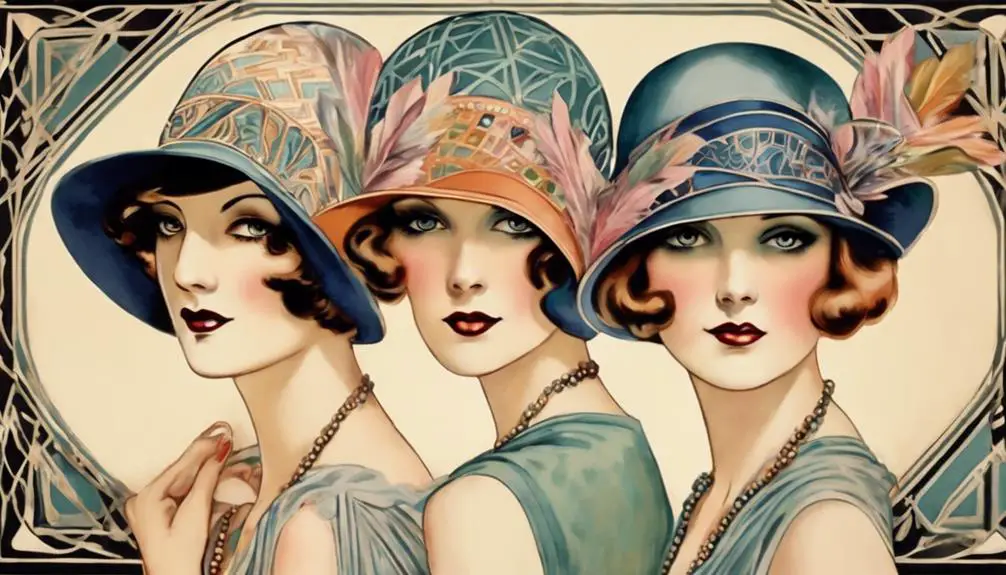
Symbolism plays an essential role in understanding the impact of cloche hats during the 1920s. These hats weren't just fashionable; they embodied the shifting social dynamics of the era. The style of a cloche could reveal a lot about the wearer. For instance, a firm knot in the ribbon signified marriage, while an arrow-like ribbon hinted at romantic interest. If you spotted a flamboyant bow, you could assume the wearer was single and enthusiastic to socialize, reflecting the decade's evolving norms. In the domain of vintage fashion, the identification of clothing labels can further enhance our understanding of pieces like cloche hats, as they often carry historical significance and craftsmanship details.
Moreover, cloche hats became iconic symbols of women's newfound independence during the flapper movement. Their bold designs, heavily influenced by Art Deco, marked a departure from traditional femininity, signaling modernity and sophistication. As you donned a cloche, you weren't merely following a trend; you were making a statement about your identity and freedom.
This hat transcended its initial popularity, becoming a timeless piece that influenced fashion trends in later decades. Ultimately, the cloche hat served as a powerful emblem of femininity, encapsulating the spirit of an era where women embraced liberation and self-expression through style.
Related Styles
Cloche hats weren't the only headwear capturing attention in the 1920s; several related styles emerged that complemented their unique aesthetic. These styles not only showcased the era's fashion sensibilities but also highlighted the diversity of women's headwear during this vibrant decade.
- Mushroom hats with their distinct rounded shapes
- Handmade flapper cloche sun hats adorned with ribbons
- Cozy wool berets for warmth
- Casual bucket hats with wide brims
- Antique horsehair lace cloche hats reflecting intricate craftsmanship
The mushroom hat, with its rounded silhouette, harmonized beautifully with the cloche's fitted design, creating a cohesive look that many women embraced. Meanwhile, handmade flapper sun hats brought a playful edge, often featuring decorative ribbons that added flair. During colder months, wool berets and beanies provided essential warmth without sacrificing style.
Emerging as a casual alternative, the bucket hat attracted a younger audience with its soft, wide brim, making it a versatile choice for everyday wear. Finally, antique horsehair lace cloche hats showcased the meticulous craftsmanship of the time, further emphasizing the 1920s' commitment to elegance and sophistication in women's fashion.
Later Fashion Trends
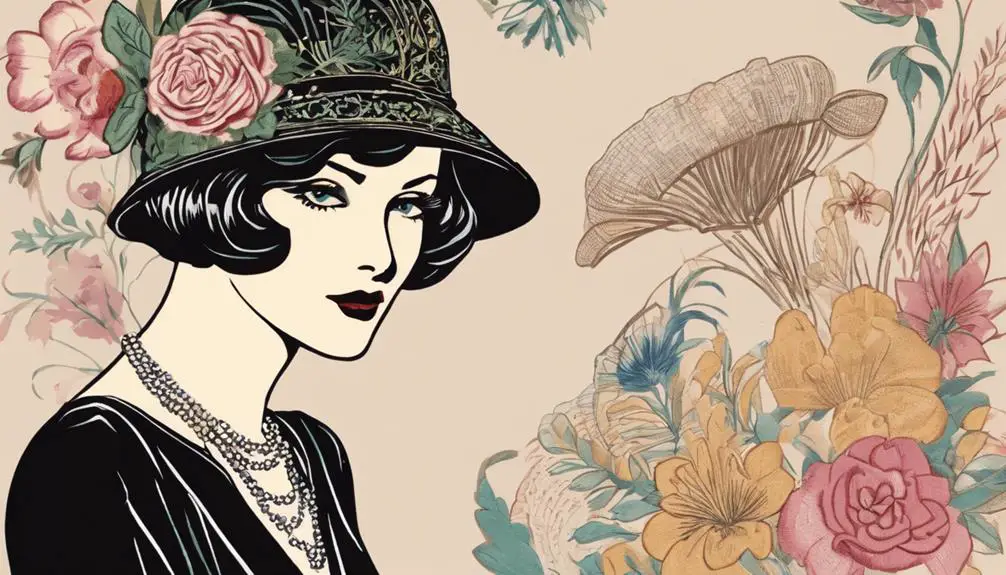
As the 1920s gave way to subsequent decades, the cloche hat evolved, leaving an indelible mark on later fashion trends. In the 1960s, you'd notice a revival of this iconic style, as younger generations embraced vintage aesthetics. The cloche, once a symbol of 1920s elegance, became a nostalgic piece that resonated with the counterculture movements of the time.
Fast forward to the 1980s, and designers began to reinterpret the cloche hat for women, introducing innovative styles like Patrick Kelly's buttoned brim that redefined the classic silhouette. This reinvention showcased the hat's versatility, allowing it to adapt to modern tastes while maintaining its historical charm.
Frequently Asked Questions
How Much Did a Cloche Hat Cost in the 1920s?
In the 1920s, you'd find cloche hats priced between $3 and $25, depending on materials and designs. The affordability of these hats made them popular, allowing you to express your style and socio-economic status.
What Is the Purpose of a Cloche Hat?
A cloche hat serves to provide warmth and protection while enhancing your style. Its close fit and elegant design frame your face beautifully, making it a versatile accessory that complements various outfits and occasions effortlessly.
When Was the Cloche Hat Popular?
The cloche hat became popular during the 1920s, marking a shift in women's fashion. It symbolized modern femininity, capturing the essence of independence and style, and resonated with the cultural changes of the Roaring Twenties.
Which Women's Hat Was Popular in the 1920S and Continued to Be Worn in the 1930S With Some Modifications?
You'll find that the cloche hat gained immense popularity in the 1920s and evolved into the 1930s, showcasing softer lines and wider brims, reflecting a shift towards a more relaxed and feminine style.
